Physical Address
304 North Cardinal St.
Dorchester Center, MA 02124
The head and neck area is arguably the most complex area of the human body; with its many physical connections to the outside environment, it plays host to myriad infectious processes. The aim of this chapter is to provide the surgical pathologist with important information that will aid in establishing an accurate diagnosis of infection. Because many of the infectious processes affecting the head and neck involve multiple sites, the chapter is organized around causative organisms rather than specific locations in the head and neck.
Acute bacterial rhinosinusitis is an uncommon complication of acute viral rhinosinusitis, and it is caused by a variety of organisms, including Streptococcus pneumoniae, Haemophilus influenzae, Moraxella catarrhalis, Staphylococcus aureus, streptococci, and various anaerobes. Signs and symptoms include purulent nasal discharge, unilateral facial pain and tenderness, and worsening symptoms, often after an initial improvement. The rare surgical specimen from a patient with acute bacterial rhinosinusitis demonstrates nonspecific findings, including congestion, edema, and subepithelial mixed inflammation showing mainly neutrophils, with chronic inflammation and fibrosis being absent.
By definition, chronic rhinosinusitis persists for at least 12 weeks despite therapy and manifests with mucopurulent drainage, nasal obstruction, facial pain or pressure, and decreased sense of smell. Chronic rhinosinusitis can be divided into three clinicopathologic syndromes: chronic rhinosinusitis with polyposis or without polyposis, and allergic fungal rhinosinusitis. The pathophysiology of chronic rhinosinusitis is complex and incompletely understood, but bacteria contribute to all forms of chronic rhinosinusitis through failed resolution of acute infection, by the formation of biofilms on the sinus mucosa, or by the stimulation of enterotoxin-specific immunoglobulin E (IgE) antibodies, as in chronic rhinosinusitis with nasal polyposis and S. aureus colonization. In contrast to acute bacterial rhinosinusitis, surgical specimens from patients with chronic rhinosinusitis are commonly seen, and histologic evaluation reveals a wide range of pathologic changes.
Gross examination may show polypoid sinonasal mucosa with varying amounts of mucus and fragments of swollen or scarred sinonasal mucosa admixed with bone fragments. The inflammatory response includes predominantly lymphocytes and plasma cells, with smaller numbers of eosinophils and neutrophils ( Fig. 7.1 ). A predominance of eosinophils should prompt consideration of allergic fungal rhinosinusitis, although this may also be seen as a component of chronic rhinosinusitis with or without polyposis. Depending on chronicity, stromal fibrosis may be sparse or marked, with hyperplasia of seromucinous glands. The respiratory mucosa varies from attenuated to hyperplastic, particularly in polypoid fragments, which typically show stromal edema, basement membrane thickening, inflammation, and fibrosis. Bone fragments may appear reactive and sclerotic or unremarkable.
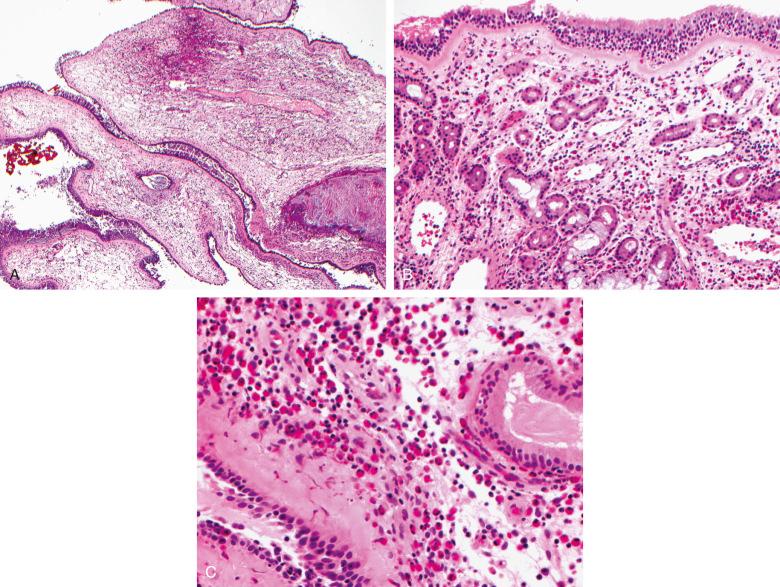
Otitis media, infection of the middle ear, may be acute or chronic. Acute otitis media is the most common disease of childhood and is usually caused by bacteria, such as S. pneumoniae, H. influenzae, and M. catarrhalis . The most common presenting symptom is earache, although patients may also demonstrate sore throat, night restlessness, or fever. Examination typically reveals a bulging opaque tympanic membrane with decreased mobility. Recurrent infections lead to chronic otitis media, which may eventually require myringotomy and tympanostomy tube placement.
The histologic findings in acute and chronic otitis media are nonspecific, and pathologists do not generally evaluate specimens from patients with acute otitis media. In patients with chronic otitis media, specimens from corrective surgery may reveal connective tissue with a mixed chronic inflammatory infiltrate, granulation tissue, metaplastic glands, and fibrosis, as well as evidence of tympanosclerosis in the form of hyalinization, calcification, or ossification of the fibrous tissues ( Fig. 7.2 ). Polypoid granulation tissue with mixed chronic inflammation and a respiratory-type or metaplastic squamous surface lining is often seen, constituting the otic or aural polyp. A giant cell reaction to cholesterol (cholesterol granuloma) is a common feature of chronic otitis. Occasionally an associated cholesteatoma is present, characterized by a cyst lined by keratinizing squamous epithelium, containing abundant acellular keratin debris, and surrounded by fibrosis, granulation tissue, and a mixed inflammatory infiltrate, often with giant cells.
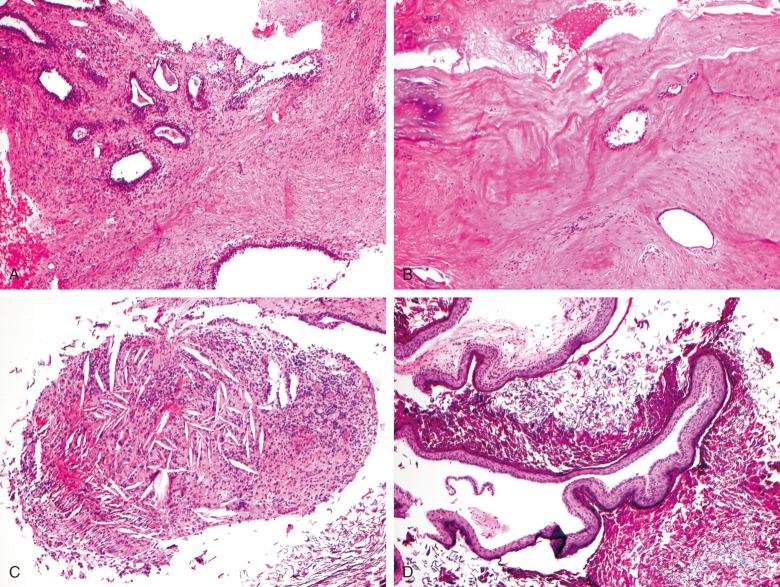
Tonsillitis is a common disease of the head and neck, and it can be acute or chronic, with a variety of bacteria and viruses as the usual etiologic culprits. Acute pharyngotonsillitis is not usually treated with surgery. It is most often attributable to infection with a respiratory virus, such as adenovirus, influenza virus, parainfluenza virus, rhinovirus, or respiratory syncytial virus, but in 30% to 40% of cases a bacterial infection is the cause, most commonly group A β-hemolytic streptococci. Recurrent infection results in chronic tonsillitis, often with tonsillar enlargement that can cause obstruction. One study identified S. aureus (30.3%), H. influenzae (15.5%), and Streptococcus pyogenes (14.4%) as the most common isolates in chronic tonsillitis, and H. influenzae (31.4%), S. pyogenes (24.2%), S. aureus (22.9%), and S. pneumoniae (12.6%) as the most common isolates in tonsillar hypertrophy.
For the most part, unless there is clinical concern for malignancy, adenoids and tonsils removed for chronic tonsillitis or hypertrophy are not processed for histologic examination. Microscopically, one sees reactive lymphoid hyperplasia, often with associated fibrosis, accentuating the interlobular fibrous septae ( Fig. 7.3 ). Acute inflammation is usually absent, and occasionally the commensal “sulfur granules” of Actinomyces can be identified between crypts. Epstein-Barr virus (EBV) and herpes simplex virus (HSV) can manifest particular histologic findings in the tonsil that are identical to those seen in lymph nodes, as discussed later in this chapter and described in detail in Chapter 12 .
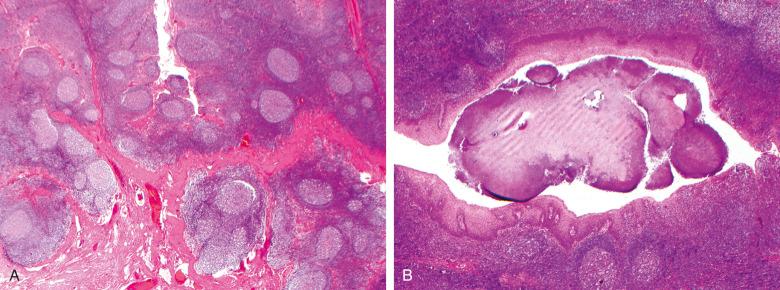
Peritonsillar abscess, or quinsy, is the most common deep infection of the head and neck. It occurs as a complication of tonsillitis and cellulitis and is a polymicrobial infection associated with a wide variety of bacteria, both aerobic and anaerobic (most commonly S. pyogenes and Fusobacterium spp., respectively). The disease affects mainly young adults during November to December and April to May, when streptococcal pharyngitis and exudative tonsillitis are at their highest incidence. Abscess forms in the area between the palatine tonsil and its capsule, causing such signs and symptoms as fever, malaise, sore throat, dysphagia, otalgia, trismus, drooling, swelling, muffled “hot potato” voice, rancid breath, and lymphadenopathy.
Lemierre syndrome (postanginal sepsis, necrobacillosis), a rare but severe complication of peritonsillar abscess most often associated with Fusobacterium necrophorum , consists of the development of internal jugular vein suppurative thrombophlebitis, which leads to septicemia and metastatic infection in the lungs and joints.
Diagnosis of peritonsillar abscess is usually made on clinical grounds with or without imaging or needle aspiration for direct examination and culture, and treatment includes antibiotic therapy and drainage. Surgical specimens demonstrate abscess formation and acute inflammation of peritonsillar connective tissues ( Fig. 7.4 ).
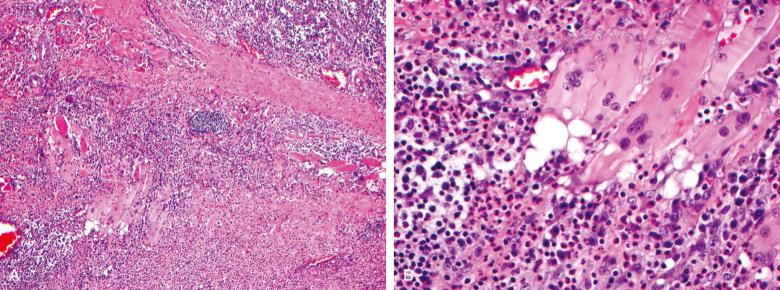
Previously referred to as “scrofulous lupus,” rhinoscleroma (scleroma) is a chronic, indolent disease that primarily affects the upper aerodigestive tract (although tracheobronchial disease may occur) and is caused by a gram-negative coccobacillus, Klebsiella rhinoscleromatis . Rare in the United States, the disease is not uncommon in endemic areas, including Central and South America, Egypt, India, and central and eastern Europe, where it affects patients in the third and fourth decades and is related to poor hygiene, overcrowding, and malnutrition, with human leukocyte antigen (HLA) research suggesting a genetic predisposition.
The disease is characterized by three distinct phases: a catarrhal (also called atrophic or rhinitic) phase, consisting of mucopurulent rhinitis lasting months to years; a proliferative or granulomatous phase, with formation of multiple firm nodules that obstruct and deform the nasal passages; and a cicatricial phase, characterized by mucosal sclerosis. Diagnosis is usually established in the proliferative phase. Microscopic findings in this phase include a submucosal mixed inflammatory infiltrate of lymphocytes and plasma cells with scattered Russell bodies, a prominent granulomatous component, and numerous clusters of foamy histiocytes known as Mikulicz cells that contain bacterial organisms. The organisms can at times be seen on hematoxylin and eosin (H&E) stain but are more readily visualized with silver impregnation stain (e.g., Warthin-Starry) ( Fig. 7.5 ). Immunohistochemical methods for bacterial detection have also been developed. The overlying respiratory mucosa may demonstrate hyperplasia, squamous metaplasia, or ulceration. The cicatricial phase is marked by extensive submucosal fibrosis with a paucity of Mikulicz cells. One group developed a diagnostic model for confirming or excluding a diagnosis of rhinoscleroma in the absence of Mikulicz cells, using a combination of various clinical and histopathologic parameters.
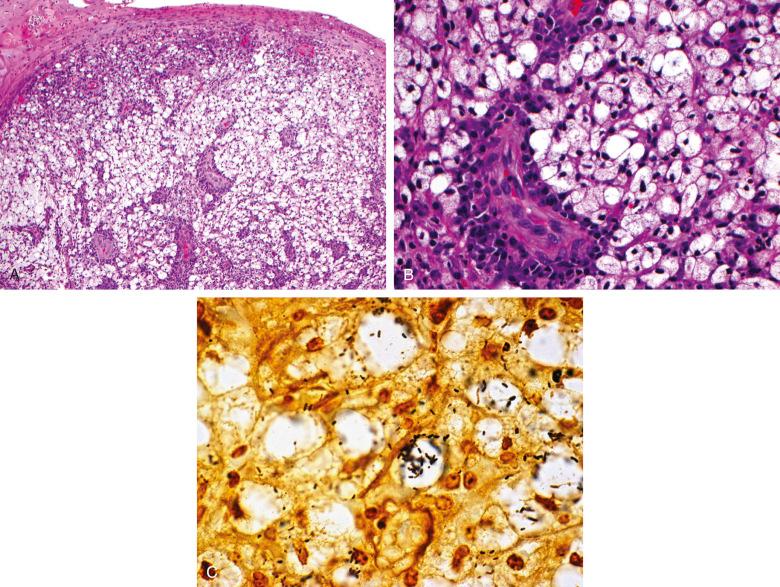
Actinomycosis is a polymicrobial bacterial infection of the orocervicofacial region caused by gram-positive anaerobic or microaerophilic filamentous oral flora of the genus Actinomyces , most commonly Actinomyces israelii . Infection follows mucosal injury, often related to dental manipulation, caries, or trauma, and usually manifests as a chronic, progressively enlarging, fluctuant purple mass at the border of the mandible, although it may also manifest as a mass or ulcer affecting the tongue, larynx, paranasal sinuses, salivary glands, or buccal mucosa, with lymph node involvement developing late in the disease course. In chronic lesions, central necrosis and abscess formation occur, and sinus tracts and fistulas may eventually develop and drain foul-smelling, purulent material containing characteristic yellow granular colonies of bacteria known as sulfur granules.
Histologic evaluation reveals mixed granulomatous and purulent inflammation with abscess formation and clusters of bacteria with central basophilia and a peripheral rim of eosinophilic, clublike projections composed of immunoglobulin, fibrin, and tissue debris; this is known as the Splendore-Hoeppli phenomenon ( Fig. 7.6 ). Organisms are highlighted on Gomori methenamine silver (GMS) and tissue Gram stains and are often seen in the crypts of routine tonsillectomy specimens removed for hypertrophy, where they most likely exist as saprophytes (see Fig. 7.3 ). Actinomyces may be confused histologically with Nocardia , which, in contrast to the former, affects predominantly immunocompromised patients, is weakly acid-fast, and is only rarely associated with orocervicofacial disease.
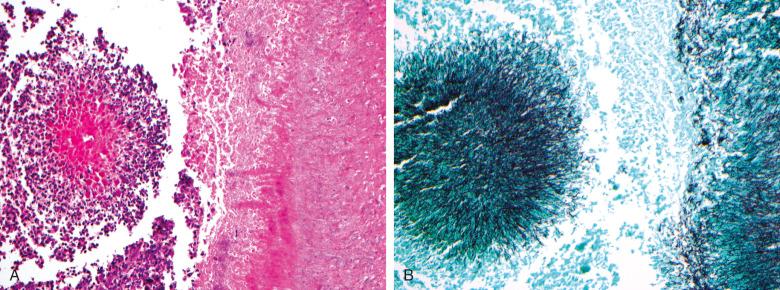
In addition to routine histology, diagnostic methods include fine-needle aspiration and molecular methods, as well as culture, which is typically of low yield. Treatment generally consists of prolonged antibiotic therapy, usually with penicillin.
The two other main forms of actinomycosis, pulmonary and abdominal disease, are covered in other chapters. In addition, whereas past literature suggested a role for Actinomyces in the pathogenesis of osteoradionecrosis and bisphosphonate-related osteonecrosis of the jaw, it is currently held that the bacteria identified in such cases represent a secondary infection of necrotic bone.
Botryomycosis is caused by a chronic bacterial infection and is analogous to mycetoma but unrelated to fungi or Actinomyces spp. It most commonly involves the subcutis but can also affect mucosal or visceral sites in rare cases. Cutaneous infections are caused most commonly by S. aureus , with Pseudomonas aeruginosa as the second most common pathogen, although reported cases suggest that P. aeruginosa may be the most common pathogen at sinonasal sites. Although the pathophysiology is incompletely understood, the disease is most commonly seen in patients with some degree of immunosuppression.
In general, botryomycosis manifests as a firm nodule or mass associated with a sinus draining granular material. Microscopic examination reveals the botryomycotic granules consisting of bacterial aggregates best appreciated with tissue Gram or silver stains, with clublike projections of amorphous eosinophilic material radiating from them (Splendore-Hoeppli phenomenon). The botryomycotic granule is surrounded by a polymorphic infiltrate of neutrophils, lymphocytes, and histiocytes. Well-formed granulomas with central necrosis may be seen, together with edema and fibrosis. Surgical management is usually necessary because these infections are resistant to medical therapy.
Since reaching an all-time nadir in 2000, the incidence of primary and secondary syphilis in the United States has increased, largely driven by cases among men who have sex with men. It remains a significant cause of morbidity in this country. The oral cavity is the most common extragenital site of infection, and the disease may affect virtually any region of the head and neck, with clinical manifestations in the primary, secondary, and tertiary stages, as well as in congenital infections.
After an incubation period of 9 to 90 days, primary syphilis manifests as one or more painless ulcers or chancres at the inoculation site, which can include the oral mucosa and tongue, associated with painless lymphadenopathy. In addition, primary infection may manifest as painless tonsillar enlargement. Histologic examination of the chancre reveals a diffuse inflammatory infiltrate of lymphocytes and plasma cells, with scattered histiocytes, neutrophils, and eosinophils ( Fig. 7.7 ). The inflammatory infiltrate shows a tendency to surround small blood vessels, producing endothelial proliferation and obliterative endarteritis; poorly formed granulomas, plasma cell neuritis, and focal necrosis can also be seen. Lymph node findings are discussed in Chapter 12 .
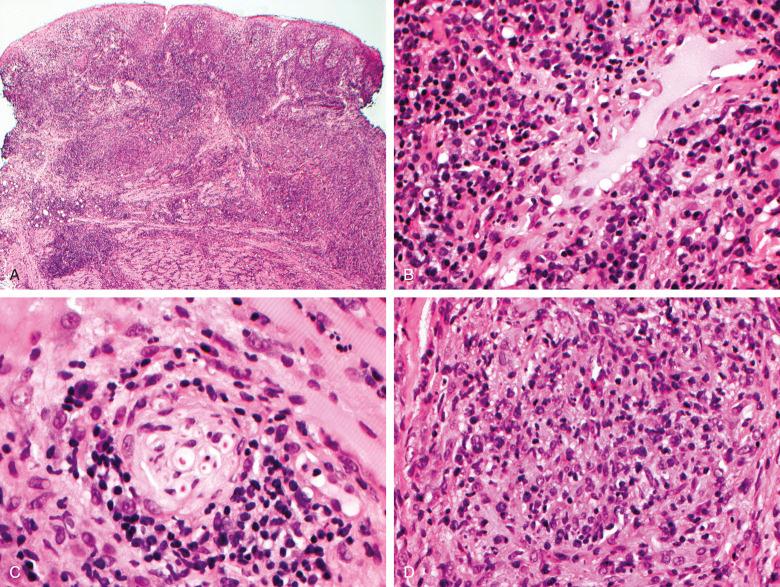
Secondary syphilis manifests 6 to 8 weeks after spontaneous recovery from the primary infection, producing flulike symptoms and a rash that often affects the palms and soles. Tonsils may be affected by highly infectious, gray-white, necrotic mucous patches with surrounding erythema, which may extend to the buccal mucosa, tongue, uvula, and soft palate. Maculopapular lesions, moist ulcers, and irregular linear “snail track” erosions can be seen, histologically characterized by dense subepithelial inflammation composed predominantly of plasma cells.
“Lues maligna,” or ulceronodular syphilis, is a rare aggressive form of secondary syphilis that most commonly affects individuals coinfected with human immunodeficiency virus (HIV). It is characterized by papulopustular skin lesions that rapidly enlarge and evolve into sharply demarcated ulcers with a central rupioid crust with associated constitutional symptoms, and it may show involvement of the mucous membranes of the mouth and nose. The histopathology is similar to that of other lesions of secondary syphilis. If untreated, patients pass into the asymptomatic latent phase of disease and lose infectivity before developing signs and symptoms of tertiary disease 4 to 8 years later.
Tertiary syphilis is characterized by multiorgan involvement and is sometimes referred to as “the great imitator” because of its protean manifestations. The gumma is the hallmark lesion of tertiary syphilis. It manifests as a painless swelling of the palate or tongue or less commonly the alveolus or parotid gland. Lesions swell and coalesce, eventually forming areas of ulceration, with possible bone destruction, palatal perforation, or oronasal fistula formation. Gummas are characterized histologically by obliterative endarteritis with necrosis and mixed inflammation consisting of plasma cells (which may be scarce), lymphocytes, epithelioid histiocytes that often form loose granulomas, and giant cells. Syphilitic leukoplakia of the tongue may also be seen and may predispose to the development of squamous cell carcinoma. The lesions appear as homogeneous white plaques on the dorsum of the tongue; histologically they show psoriasiform hyperplasia and parakeratosis of the mucosa with infiltrates of lymphocytes, plasma cells, and histiocytes. Interstitial glossitis also occurs. Spirochetal sensorineural hearing loss is an infrequent late consequence of acquired syphilis.
Congenital syphilis occurs after transplacental spread during pregnancy and can result in numerous abnormalities in surviving affected progeny. Early signs of congenital infection typically occur between 1 month and 2 years of age and include rhinitis (“snuffles”), vesiculobullous eruptions of the mucous membranes, and radial perioral skin lesions (“rhagades”). Late signs occur after 2 years and include keratitis (often leading to blindness) and eighth nerve deafness, as well as more typical signs of tertiary syphilis. Such patients are additionally affected by typical orofacial stigmata, including tooth abnormalities (Hutchinson incisors, Fournier “mulberry” molars, and Moon molars), saddle nose deformity (caused by destruction of the vomer), frontoparietal bossing, and maxillary hypoplasia (“bulldog jaw”).
The diagnosis of syphilis may be accomplished in several ways. In the primary and secondary stages, as well as in early congenital disease, lesions contain numerous spiral-shaped treponemal organisms, often within the surface epithelium, surrounding small vessels and within macrophages, and they can be visualized with the Warthin-Starry stain, immunohistochemistry, or darkfield microscopy. However, microscopic findings should be interpreted with caution, because spirochetes are part of the normal flora of the oral cavity. Serologic techniques are currently the mainstay of diagnosis and include both treponemal (specific) and nontreponemal (nonspecific) antibody tests. Nonspecific tests include the Venereal Disease Research Laboratory (VDRL) and the rapid plasma reagin (RPR) tests, which are rapid and inexpensive and traditionally have served as screening tests. Specific tests, such as the fluorescent treponemal antibody-absorbed (FTA-ABS) assay, should be performed for confirmation of the diagnosis. No single test should be used alone in making a diagnosis of syphilis.
Become a Clinical Tree membership for Full access and enjoy Unlimited articles
If you are a member. Log in here